McDonnell FH Phantom Video - Overview
|
|
McDonnell FH Phantom
FH Phantom
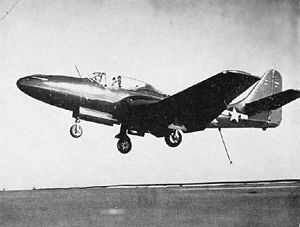
Picture - McDonnell FH-1 Phantom
Role: Carrier-based fighter aircraft
Manufacturer: McDonnell Aircraft
First flight: 26 January 1945
Introduced: August 1947
Retired: 1949 USN, USMC
1954 USNR
Primary users: United States Navy
United States Marine Corps
Number built: 62
Developed into: F2H Banshee
The McDonnell FH Phantom was a twin-engined jet fighter aircraft designed and first flown during World War II for the United States Navy. The Phantom was the first purely jet-powered aircraft to land on an American aircraft carrier and the first jet deployed by the United States Marine Corps. Although its front-line service was relatively brief, it helped prove the viability of carrier-based jet fighters to the leadership of the US Navy. Furthermore, it was McDonnell's first successful fighter, leading to the development of the follow-on F2H Banshee, one of the two most important naval jet fighters of the Korean War.
The FH Phantom was originally designated as the FD Phantom, but the designation was changed as the aircraft entered production.
Design and development
In early 1943, aviation officials at the US Navy were impressed with McDonnell's audacious XP-67 Bat project. McDonnell was invited by the Navy to cooperate in the development of a shipboard jet fighter, using an engine from the turbojets under development by the Westinghouse Electric Corporation. Three prototypes were ordered on 30 August 1943 and the designation XFD-1 was assigned. Under the 1922 United States Navy aircraft designation system, the letter "D" before the dash designated the aircraft's manufacturer. The Douglas Aircraft Company had previously been assigned this letter, but the USN elected to reassign it to McDonnell because Douglas had not provided any fighters for Navy service in years.
McDonnell engineers evaluated a number of engine combinations, varying from eight 9.5 in (24 cm) diameter engines down to two engines of 19 inch (48 cm) diameter. The final design used the two 19 in (48 cm) engines after it was found to be the lightest and simplest configuration. The engines were buried in the wing root to keep intake and exhaust ducts short, offering greater aerodynamic efficiency than underwing nacelles, and the engines were angled slightly outwards to protect the fuselage from the hot exhaust blast. Placement of the engines in the middle of the airframe allowed the cockpit with its bubble-style canopy to be placed ahead of the wing, granting the pilot excellent visibility in all directions. This engine location also freed up space under the nose, allowing designers to use tricycle gear, thereby elevating the engine exhaust path and reducing the risk that the hot blast would damage the aircraft carrier deck. Unlike the somewhat unconventional XP-67, the construction methods and aerodynamic design of the Phantom were fairly conventional for the time; the plane had unswept wings, a conventional empennage, and an aluminum monocoque structure with flush riveted aluminum skin. Folding wings were used to reduce the width of the aircraft in storage configuration. Provisions for four .50-caliber (12.7 mm) machine guns were made in the nose, while racks for eight 5 in (127 mm) high-explosive unguided air-to-ground rockets could be fitted under the wings. Adapting a jet to carrier use was a much greater challenge than producing a land based fighter because of slower landing and takeoff speeds required on a small carrier deck. The Phantom used split flaps on both the folding and fixed wing sections to enhance low-speed landing performance, but no other high-lift devices were used. Provisions were also made for Rocket Assisted Take Off (RATO) bottles to improve takeoff performance.
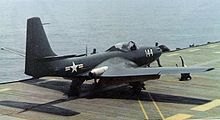
Picture - A U.S. Navy FH-1 of VF-17A Phantom Fighters taxis to the catapult during carrier qualifications on the light aircraft carrier USS Saipan (CVL-48), in May 1948
When the first XFD-1 was completed in January 1945, only one Westinghouse 19XB-2B engine was available for installation. Ground runs and taxi test were conducted with the single engine, and such was the confidence in the aircraft that the first flight on 26 January 1945 was made with only the one turbojet engine. With successful completion of tests, a production contract was awarded on 7 March 1945 for 100 FD-1 aircraft. However, during the Phantom's development, Douglas Aircraft had announced its intent to compete for several new Navy aircraft contracts. This prompted the Navy to grant the designation letter "D" back to Douglas and reassign the then-unused letter "H" to McDonnell, thereby changing the designation of the production Phantom to FH-1. With the end of the war, the Phantom production contract was reduced to 30 aircraft, but was soon increased to 60.
The second and final Phantom prototype became the first purely jet-powered aircraft to operate from an American aircraft carrier, completing four successful takeoffs and landings on 21 July 1946, from USS Franklin D. Roosevelt. At the time, she was the largest carrier serving with the USN, allowing the plane to take off without assistance from a catapult.
Production Phantoms incorporated a number of design improvements. These included provisions for a flush-fitting centerline drop tank, an improved gunsight, and the addition of speed brakes. Production models used Westinghouse J30-WE-20 engines with 1,600 lbf (7.1 kN) of thrust per engine. The top of the vertical tail had a more square shape than the rounder tail used on the prototypes, and a smaller rudder was used to resolve problems with control surface clearance discovered during test flights. The horizontal tail surfaces were shortened slightly while the fuselage was stretched by 19 in (48 cm). The amount of framing in the windshield was reduced to enhance pilot visibility.
Realizing that the production of more powerful jet engines was imminent, McDonnell engineers proposed a more powerful variant of the Phantom while the original plane was still under development - a proposal that would lead to the design of the Phantom's replacement, the F2H Banshee. Although the new plane was originally envisioned as a modified Phantom, the need for heavier armament, greater internal fuel capacity, and other improvements eventually led to a substantially heavier and bulkier airplane that shared few parts with its lithe predecessor.
Operational history
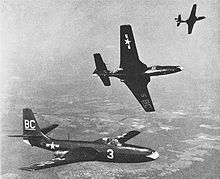
Picture - Three FH-1 Phantoms of VMF-122 in 1949
The first Phantoms were delivered to USN fighter squadron VF-17A (later redesignated VF-171) in August 1947; the squadron received a full complement of 24 aircraft on 29 May 1948. Beginning in November 1947, Phantoms were delivered to US Marine squadron VMF-122, making it the first USMC combat squadron to deploy jets. VF-17A became the USN's first fully operational jet carrier squadron when it deployed aboard USS Saipan on 5 May 1948.
The Phantom was one of the first jets used by the U.S. military for exhibition flying. Several Phantoms used by the Naval Air Test Center fell into the hands of a unique demonstration team called the Gray Angels, whose members consisted entirely of Marine aviators holding the rank of General. The team's name was an obvious play on the name of the recently-formed USN Blue Angels, who were still flying propeller-powered F8F Bearcats at the time. The "Grays" flew in various air shows during the summer of 1947, but the team was abruptly disbanded after their poorly timed arrival at a September air show in Cleveland, Ohio nearly caused a head-on low-altitude collision with a large formation of other aircraft. The VMF-122 Phantoms were later used for air show demonstrations until they were taken out of service in 1949, with the team being known alternately as the Marine Phantoms or the Flying Leathernecks.
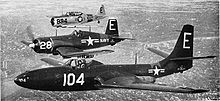
Picture - Three aircraft of the Minneapolis U.S. Naval Air Reserve (front to back): an FH-1 Phantom, an F4U-1 Corsair, and an SNJ Texan in 1951.
The Phantom's service as a front-line fighter would be short-lived. Its limited range and light armament- notably its inability to carry bombs- made it best suited for duty as a point-defence interceptor. However, its speed and rate of climb were only slightly better than existing propeller-powered fighters and fell short of other contemporary jets such as the P-80 Shooting Star, prompting concerns that the Phantom would be outmatched by future enemy jets it might soon face. Moreover, recent experience in World War II had demonstrated the value of naval fighters that could double as fighter-bombers, a capability the Phantom lacked. Finally, the plane exhibited some design deficiencies- its navigational avionics were poor, it could not accommodate newly-developed ejection seats, and the location of the machine guns atop the plane's nose caused pilots to be temporarily blinded by muzzle flash when firing the guns at night.
The USN's Phantoms were widely used for carrier qualifications, but little combat training was ever carried out by the planes. The F2H Banshee and F9F Panther, both of which began flight tests around the time of the Phantom's entry into service, better satisfied the Navy's desire for a versatile, long-range, high-performance jet. Consequently, the Phantom was quickly declared obsolete and served most widely as a trainer for pilots whose squadrons were awaiting Panther or Banshee deliveries, starting in August 1948 when the Phantoms of VF-17A were dispersed to other units. The FH-1 was entirely withdrawn from USN and USMC service by late 1949, prior to the outbreak of the Korean War. The planes would see training duty with the USNR until 1954. No Phantom would ever see combat.
The FH Phantom is perhaps best known for lending its name to the vastly more successful and longer-serving F-4 Phantom II.
Civilian use
In 1964, Progressive Aero, Incorporated of Fort Lauderdale, Florida purchased 3 surplus Phantoms, intending to use them to teach civilians how to fly jets. A pair of the planes were stripped of military equipment and restored to flying condition, but the venture was unsuccessful, and the planes were soon retired once again.
Variants
XFD-1 prototype aircraft powered by 1,165 lb (528 kg) Westinghouse 19XB-2B engines. Two built (BuNo 48235-48236). FH-1 (FD-1) production version with 1,600 lb (730 kg) Westinghouse J30-WE-20 engines (originally designated FD-1). 60 built (BuNo 111749-111808).
Operators
United States
United States Navy
VF-17A
Naval Air Reserve
United States Marine Corps
VMF-122
VMF-311
Aircraft on display
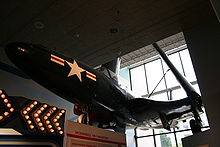
Picture - FH-1 Phantom on display in Washington, D.C.
Two Phantoms are known to exist today. A restored Phantom is displayed at the National Air and Space Museum of the Smithsonian Institution in Washington, D.C., United States, while one of the former Progressive Aero planes is displayed at the National Museum of Naval Aviation at Naval Air Station Pensacola, Florida. Another of the former Progressive Aero Phantoms may be in storage in Fort Lauderdale, but its status is unknown.
Specifications (FH-1 Phantom)
Data from McDonnell Douglas Aircraft since 1920
General characteristics
Crew: One
Length: 37 ft 3 in (11.35 m)
Wingspan: 40 ft 9 in; 16 ft 3 in with folded wings (12.42 m / 4.95 m)
Height: 14 ft 2 in (4.32 m)
Wing area: 276 sq ft (25.6 m²)
Empty weight: 6,683 lb (3,031 kg)
Loaded weight: 10,035 lb (4,552 kg)
Max takeoff weight: 12,035 lb (5,459 kg)
Powerplant: 2x— Westinghouse J30-WE-20 turbojets, 1,600 lbf (7.1 kN) each
Fuel capacity: 375 gal (1,420 l) internal, 670 gal (2,540 l) with external drop tank
Performance
Maximum speed: 417 knots (479 mph, 771 km/h) at sea level
Cruise speed: 216 knots (248 mph, 399 km/h)
Range: 604 nmi (695 mi, 1,120 km)
Ferry range: 852 nmi (980 mi, 1,580 km) with external drop tank
Service ceiling: 41,100 ft (12,525 m)
Rate of climb: 4,230 ft/min (21.5 m/s)
Wing loading: 36.4 lb/ft² (178 kg/m²)
Thrust/weight: 0.32
Armament
Guns: 4 x— .50 in (12.7 mm) machine guns
Related development
F2H Banshee
Comparable aircraft
FJ-1 Fury
F6U Pirate
de Havilland Sea Vampire
Related lists
List of fighter aircraft
List of military aircraft of the United States
Citations
Bibliography
Angelucci, Enzo. The American Fighter. Sparkford, Somerset: Haynes Publishing Group, 1987. ISBN 0-85429-635-2.
Green, William. War Planes of the Second World War, Volume Four: Fighters. London: MacDonald & Co. (Publishers) Ltd., 1961 (Sixth impression 1969). ISBN 0-356-01448-7.
Green, William and Swanborough, Gordon. WW2 Aircraft Fact Files: US Navy and Marine Corps Fighters. London, UK: Macdonald and Jane's, 1976. ISBN 0-356-08222-9.
Mills, Carl. Banshees in the Royal Canadian Navy. Willowdale, Ontario, Canada: Banshee Publication, 1991. ISBN 0-9695200-0-X.
"Mr Mac's First Phantom: The Story of the McDonnell FH-1". Air International, November 1987, Vol 33 No 5. Bromley, UK:Fine Scroll. ISSN 0306-5634. pp. 231-235, 258-260.
Francillon, René J. McDonnell Douglas Aircraft since 1920. London, England: Putnam & Company, Ltd, 1979. ISBN 0-370-00050-1.
Mesko, Jim. FH Phantom/F2H Banshee in action. Carrollton, Texas, USA: Squadron/Signal Publications, Inc, 2002. ISBN 0-89747-444-9.
McDonnell FH Phantom Pictures and McDonnell FH Phantom for Sale.
Living Warbirds: The best warbirds DVD series.
Source: WikiPedia